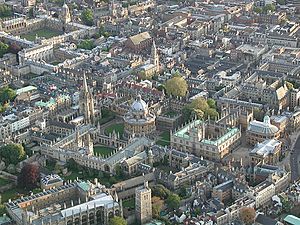History of Oxford facts for kids
The history of Oxford is a long and interesting story about a famous city in England. Oxford started as a small settlement during the Saxon period. It was a very important place because it controlled a key crossing point on the River Thames, where it met the River Cherwell.
As time went on, Oxford became even more important, especially during the Norman period. A big change happened in the 12th century when the University of Oxford was founded. This university grew to be a huge part of the city's life. Sometimes, there were conflicts between the university students and staff (known as "gown") and the local people (known as "town"). These were called town and gown conflicts.
Oxford faced many challenges throughout its history. In 1142, the city was attacked during a time of civil war called The Anarchy. Later, in the early 13th century, Oxford Castle was attacked during the First Barons' War. The city was also greatly changed by the English Reformation, which was started by Henry VIII when he closed down many monasteries.
During the English Civil War, Oxford played a very important role. It became the home of King Charles I and his court. Because of this, the city was attacked again.
In the 19th and 20th centuries, Oxford grew a lot. It became a center for big industries like printing and car manufacturing. However, these industries started to decline in the 1970s and 1980s. Today, Oxford is mostly known for its world-famous university and its busy tourist industry.
Contents
Early Beginnings of Oxford
Oxford's story began in the Saxon times. Its name likely comes from "Oxenaforda," meaning "ford of the oxen." A ford is a shallow place in a river where people and animals can cross. This crossing point was very important for trade and travel.
The city's location at the meeting of the River Thames and the River Cherwell made it a strategic spot. It was easy to defend and control movement along the rivers. This helped Oxford grow from a small settlement into a more significant town.
Oxford in the Middle Ages
During the Norman period, after the Norman conquest of England, Oxford continued to grow. The Normans built Oxford Castle in the 11th century to help control the area. This castle was a strong fortress and played a role in several conflicts.
One major event was the siege in 1142. This happened during a civil war known as The Anarchy, when different groups fought for control of England. Oxford Castle was also attacked during the First Barons' War in the early 1200s. These events show how important Oxford was in medieval English history.
The Rise of Oxford University
The University of Oxford was founded in the 12th century, making it one of the oldest universities in the world. Its growth had a huge impact on the city. Students and scholars came from all over, changing the feel of Oxford.
Sometimes, there were disagreements between the university community and the local townspeople. These were called "town and gown" conflicts. "Town" referred to the residents, and "gown" referred to the university members, who often wore academic gowns. These conflicts could sometimes become quite serious.
Changes During the Reformation
The English Reformation in the 16th century brought big changes to Oxford. King Henry VIII decided to break away from the Roman Catholic Church. As part of this, he ordered the dissolution of the monasteries.
Oxford had many monasteries and religious houses. Their closure meant a lot of property and wealth changed hands. This period also led to new ways of thinking and learning, which influenced the university and the city.
Oxford in the English Civil War
In the 17th century, England was torn apart by the English Civil War. This war was fought between King Charles I and Parliament. Oxford became a very important place during this time.
King Charles I made Oxford his capital and set up his court there. This meant the city was at the heart of the Royalist efforts. Because of its importance, Oxford was besieged by Parliament's forces. The city eventually surrendered in 1646, marking a key moment in the war.
Modern Oxford: Industry and Tourism
In the 19th and 20th centuries, Oxford saw a lot of growth and change. The city became a center for new industries. Large printing companies set up factories, and car manufacturing became a major industry.
However, in the 1970s and 1980s, many of these traditional industries started to decline. Today, Oxford is no longer known for its heavy industry. Instead, it is famous worldwide for its excellent education system, especially the university, and for being a popular place for tourists to visit. People come from everywhere to see its historic buildings and colleges.
Images for kids
-
The Radcliffe Camera, completed in 1748





